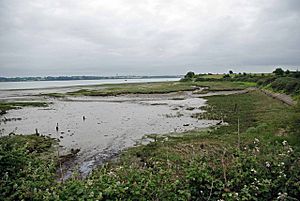Wrabness Nature Reserve facts for kids
Quick facts for kids Wrabness Nature Reserve |
|
|---|---|

River Stour and Wrabness Nature Reserve
|
|
| Type | Local Nature Reserve |
| Location | Wrabness, Essex |
| OS grid | TM161316 |
| Area | 27.0 hectares |
| Managed by | Essex Wildlife Trust |
Wrabness Nature Reserve is a fantastic natural area located in Essex, England. It covers about 27 hectares, which is roughly the size of 40 football fields! This special place sits right on the south bank of the River Stour, near the village of Wrabness. It is managed by the Essex Wildlife Trust, an organization that works hard to protect wildlife and wild places. Wrabness Nature Reserve is officially recognized as a Local Nature Reserve, meaning it's important for its natural features and wildlife, and it's a wonderful spot for people to explore and connect with nature.
Contents
Discover Wrabness Nature Reserve
Wrabness Nature Reserve is a mix of different natural areas, making it a home for many types of plants and animals. You can find open grasslands, wet marsh areas, dense scrub, and peaceful woodlands here. Each of these habitats provides a unique environment for different species to live and grow.
Amazing Animals You Can See
The reserve is a paradise for birdwatchers, with a wide variety of birds living there or visiting throughout the year.
Birds of Wrabness
You might spot colorful yellowhammers singing from the bushes, or hear the sweet song of song thrushes. The whitethroat is another common visitor, known for its scratchy song. If you are lucky, you might even see a short-eared owl hunting over the grasslands.
Winter Visitors
During the colder months, many birds travel to Wrabness from other places. These winter visitors include elegant black-tailed godwits, sleek grey plovers, and busy turnstones searching for food along the water's edge.
Tiny Creatures
It's not just birds that call Wrabness home! The reserve also has a huge variety of invertebrates. These are small creatures without backbones, like insects, spiders, and worms. They play a very important role in the ecosystem, helping plants grow and providing food for birds and other animals.
Plants and Habitats
The different types of land at Wrabness Nature Reserve support a wide range of plant life.
What Grows Here?
In the grasslands, you might find interesting plants like corn mint and hairy buttercups. The mix of grassland, marsh, scrub, and woodland creates diverse habitats. These different areas mean that many different types of plants can thrive, from those that like wet soil to those that prefer drier ground.
Keeping the Grasslands Healthy
To make sure the grasslands stay healthy and don't get too overgrown, the Essex Wildlife Trust sometimes lets animals graze there. Grazing means that animals like cows or sheep eat the grass. This helps to keep the vegetation from becoming too thick and rough, which allows smaller, more delicate plants to grow and provides better habitats for insects and other small creatures.
How to Visit Wrabness Nature Reserve
Wrabness Nature Reserve is open for visitors to enjoy. You can easily get to the reserve from Whitesheaf Lane. It's a great place to go for a walk, watch birds, or simply enjoy the peace and quiet of nature. Remember to stick to the paths and respect the wildlife when you visit.

